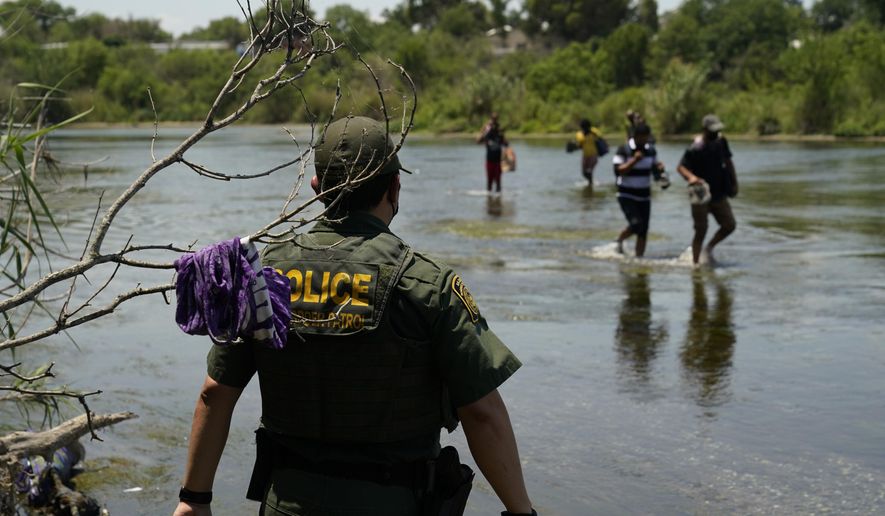At least 270,000 migrants have sneaked into the U.S. and burrowed into communities across the country so far this fiscal year, according to the latest Border Patrol data.
Agents know them as “gotaways” who represent an acute national security risk, according to the head of the National Sheriffs’ Association’s border security committee.
Unlike the migrant children who often surrender to border authorities and the migrants who are caught and screened before release, gotaways sneak through the country’s defenses without any look into their criminal histories.
The Border Patrol is missing about 1,100 of them a day, said Sheriff Mark Dannels of Cochise County, Arizona, who got his numbers directly from the agency.
“These are people that are coming dressed head to toe in camouflage, being smuggled by the cartels,” Sheriff Dannels said. “That is a public safety and national security risk to this country.”
He said his region of southeastern Arizona has borne the brunt of the gotaway traffic, with 90,000 so far this fiscal year.
That is surprising because Texas is getting more migrants overall.
Customs and Border Protection, the Homeland Security agency that guards the nation’s boundaries, didn’t explain why Arizona is experiencing the worst of the crisis.
But agents in the Border Patrol’s Tucson sector have been pulled off the line and deployed on missions to process and care for migrant parents and children. These migrants generally want to be caught so they can take advantage of more relaxed enforcement.
Sheriff Dannels said 300 agents have been moved out of one Border Patrol station and three highway checkpoints have been shut down for months, creating an easier path to get deep into the country.
The Department of Homeland Security has a sense of who is crossing, thanks to a network of cameras and sensors stretched along the southern boundary with Mexico. Subtract how many people are caught, and the difference is the number of known gotaways.
Sheriff Dannels runs his own network of cameras in Cochise and surrounding areas. He said the apprehension rate there is running at only about 36%. The rest are gotaways.
The Texas Department of Public Safety also runs a network of cameras under a program known as Operation Drawbridge. Its numbers suggest the gotaways rate is steadily increasing.
From Jan. 1 to April 7, the department recorded 21,904 gotaways, or nearly 230 a day. From April 8 to July 15, it tallied 32,600 gotaways, or more than 330 a day.
From April 8 to July 15 last year, Texas spotted only about 50 gotaways per day.
The federal numbers, which cover the entire border, span the fiscal year dating back to Oct. 1. But the vast majority of the 270,000 gotaways have arrived since January, when President Biden took office and oversaw a more relaxed approach to border jumpers.
Spurred by those changes, migrants are rushing the border in numbers not seen in 21 years. Border Patrol agents nabbed more than 178,000 in June, or about 5,900 a day. Add the 1,100 gotaways, and the number of people crossing is more than 7,000 a day.
Sometimes agents have to infer a gotaway from a sensor hit or a set of footprints. Other times, agents have migrants in their grasp but are unable to hold them.
That was what happened to agents manning a highway checkpoint in western Texas last week.
A Nissan Armada rolled into the wrong lane. When agents tried to get a better look inside the SUV, the driver sped up and barrelled through the checkpoint at more than 110 mph, according to court documents. Border Patrol vehicles are limited to 100 mph.
The driver eventually pulled over, and nine migrants jumped out of the vehicle. Seven disappeared into the brush, and the two who were caught told agents that the driver said they had better run fast because the Border Patrol would “shoot them all.”
Texas state troopers spiked the Nissan’s tires to bring the vehicle to a stop, and agents arrested the driver.
The two migrants caught said the driver had been smoking methamphetamine from a pipe. Authorities said they saw him toss a pipe out the window.
Sheriff Dannels said he has a good working relationship with the agents in his region. Although they are doing their best, he said, the policies from Washington have created an impossible situation.
Experts say danger is lurking in the gotaway population.
The gotaways are the ones who don’t want to be caught. Smuggling cartels that control border traffic take special pains to send these migrants when they know agents are occupied elsewhere. The cartels sometimes send large groups of families specifically for distraction.
“I would say a lot of them are undesirables,” Border Patrol agent Ron Boren told the Center for Immigration Studies’ Todd Bensman this year. “The criminal aliens who have been convicted in the United States, the guys convicted of rape, theft, multiple DUIs and lord knows whatever else.”
Mr. Bensman was in western Texas tracking gotaways through the Big Bend area. One agent told him they might be catching only 10% of the traffic across that area.
• Stephen Dinan can be reached at sdinan@washingtontimes.com.




Please read our comment policy before commenting.